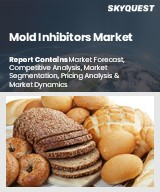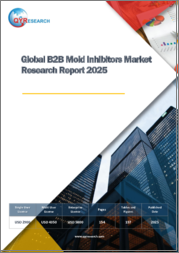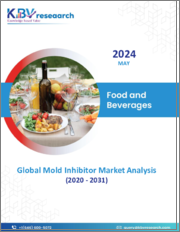
|
시장보고서
상품코드
1489343
곰팡이 방지제 시장 예측(-2030년) : 제품 유형, 형태, 용도, 최종사용자, 지역별 세계 분석Mold Inhibitors Market Forecasts to 2030 - Global Analysis By Product (Benzoates, Parabens, Propionates, Sorbates and Other Products), Type, Form, Application, End User and By Geography |
||||||
Stratistics MRC에 따르면 곰팡이 방지제 세계 시장은 2023년에 20억 달러를 차지하며, 예측 기간 중 CAGR은 5.5%로 성장하며, 2030년에는 29억 달러에 달할 것으로 예측되고 있습니다.
곰팡이 방지제는 곰팡이와 흰곰팡이의 번식을 방지하거나 억제하는 데 사용되는 물질 또는 화학 물질입니다. 곰팡이 방지제는 구조적 손상, 건강 위험 및 불쾌한 냄새와 같은 곰팡이의 유해한 영향으로부터 보호하기 위해 다양한 제품 및 환경에서 일반적으로 사용됩니다. 곰팡이 방지제는 건축자재(페인트, 코팅제, 밀봉제 등), 식품 및 음료 방부제, 개인 위생용품, 세정제 등 다양한 제품에서 발견됩니다. 가정, 상업용 건물, 식품 저장 시설 등 곰팡이 번식이 우려되는 환경에서 곰팡이 없는 건강한 환경을 유지하는 데 중요한 역할을 합니다.
식품 관련 건강 문제 및 인식 증가
식품과 관련된 건강 문제가 지속적으로 증가함에 따라 시장에서는 안전한 식품에 대한 인식과 수요가 증가하고 있습니다. 소비자들은 곰팡이로 오염된 식품과 관련된 잠재적 건강 위험에 대한 관심이 높아지고 있습니다. 이러한 추세는 식품의 안전과 품질을 보장하기 위해 혁신적이고 자연적이며 무해한 곰팡이 억제 솔루션의 개발과 채택으로 시장을 주도하고 있습니다. 제조업체들은 이러한 시급한 건강 문제를 해결하기 위해 지속가능하고 효과적인 방법에 초점을 맞추어 대응하고 있습니다.
첨단 기술 및 보관 시설 부족
시장은 첨단 기술 부족과 불충분한 저장 시설로 인한 문제에 직면해 있습니다. 이는 곰팡이 방지제의 효율적인 생산, 유통 및 보관을 방해하고 제품의 품질과 유통기한에 영향을 미칩니다. 자동 제조 및 정밀한 모니터링 시스템과 같은 최신 기술이 없다면 업계는 지속적으로 수요를 충족시키는 데 어려움을 겪을 것입니다. 또한 저장 시설의 부족으로 인해 재고 관리 문제가 발생하여 공급망 효율성과 시장 경쟁에 영향을 미치고 있습니다. 이러한 한계는 곰팡이 방지제 분야의 기술 투자와 발전의 필요성을 강조하고 있습니다.
보존기간 연장에 대한 수요 증가
식품 안전과 보존에 대한 소비자의 인식이 높아지면서 유통기한이 연장된 제품에 대한 수요가 급증하고 있습니다. 이러한 추세는 식품 및 음료, 제약, 화장품 등 다양한 산업에서 지속가능하고 품질 중심의 솔루션에 대한 선호도가 높아지고 있음을 반영하고 있습니다. 이러한 소비자 니즈 변화에 대응하기 위해 안전성과 유효성을 유지하면서 제품의 신선도와 수명을 보장할 수 있는 혁신적인 곰팡이 방지제 개발이 주목받고 있습니다.
원재료 가격 변동
시장에서는 수급 변동, 작물 수확량에 영향을 미치는 날씨, 무역 경로에 영향을 미치는 지정학적 사건, 환율 변동 등 다양한 요인으로 인해 원자재 가격이 크게 변동하는 경우가 많습니다. 이러한 변동은 생산 비용에 직접적인 영향을 미치고, 궁극적으로 시장내 가격 전략에 영향을 미치기 때문에 업계 관계자들에게 도전과 기회로 작용할 수 있습니다.
COVID-19의 영향 :
COVID-19 팬데믹은 시장에 큰 영향을 미쳤습니다. 위생에 대한 관심이 높아지면서 가정과 상업 공간에서 곰팡이 번식을 억제하는 제품에 대한 수요가 증가하면서 초기에는 수요가 급증했습니다. 그러나 공급망의 혼란, 경제의 불확실성, 소비자의 우선순위 변화로 인해 수요 변동이 발생했습니다. 시장은 환경 친화적 인 솔루션을 강조하고 제품의 효능을 향상시킴으로써 시장에 적응했습니다. 전반적으로 전염병은 소비자 선호도와 시장 역학을 재구성했습니다.
예측 기간 중 프로피오네이트 부문이 가장 큰 시장으로 성장할 것으로 예상됩니다.
프로피오네이트 부문은 예측 기간 중 가장 큰 시장이 될 것으로 예상됩니다. 프로피오네이트가 널리 사용되는 이유는 다양한 음료 및 식품에서 곰팡이 번식을 방지하고 유통기한을 연장하며 제품의 안전성을 보장하기 때문입니다. 프로피오네이트는 중요한 대사 과정을 억제하여 곰팡이 발생을 억제하고 제품의 품질과 신선도를 유지하기 위한 식품 업계의 노력에 필수적인 역할을 합니다. 안전하고 오래 지속되는 식품에 대한 소비자의 요구가 증가함에 따라 프로피오네이트는 곰팡이 억제 전략에서 중요한 역할을 하고 있습니다.
예측 기간 중 가장 높은 CAGR을 나타낼 것으로 예상되는 산업 부문
산업 부문은 다양한 산업에서 고급 솔루션에 대한 수요가 증가함에 따라 예측 기간 중 가장 높은 CAGR을 나타낼 것으로 예상됩니다. 이러한 방지제는 곰팡이와 곰팡이의 번식을 방지하고 제품의 품질과 안전을 보장하는 데 중요한 역할을 합니다. 엄격한 규제 기준, 곰팡이 관련 건강 위험에 대한 인식 증가, 곰팡이 방지 기술 발전과 같은 주요 요인이 시장 확대를 주도하고 있습니다.
가장 큰 점유율을 차지하는 지역
예측 기간 중 북미가 가장 큰 시장 점유율을 차지할 것으로 예상됩니다. 소비자들은 곰팡이 번식을 방지하기 위해 페인트, 코팅제 및 건축자재에 곰팡이 방지제를 선택하고 있습니다. 이 시장은 장기적인 건물의 무결성을 위해 곰팡이 방지가 중요한 건설 부문에서 큰 수요가 있습니다. 주요 업체들은 환경 친화적이고 오래 지속되는 솔루션 개발에 주력하고 있으며, 이는 이 지역 시장 성장을 더욱 촉진하고 있습니다.
CAGR이 가장 높은 지역 :
예측 기간 중 아시아태평양이 가장 높은 CAGR을 유지할 것으로 예상됩니다. 이 지역의 식품 가공 산업은 도시화, 소비자 라이프스타일의 변화, 가처분 소득 증가 등의 요인으로 인해 빠르게 성장하고 있습니다. 또한 많은 국가의 규제기관은 식품 안전 및 품질에 대한 엄격한 가이드라인과 규제를 시행하고 있습니다. 이에 따라 식품 제조업체들은 이러한 기준을 준수하고 제품이 안전하게 소비될 수 있도록 노력하고 있으며, 이에 따라 곰팡이 방지제에 대한 수요는 더욱 증가하고 있습니다.
무료 맞춤형 서비스 :
이 보고서를 구독하는 고객은 다음과 같은 무료 맞춤화 옵션 중 하나를 사용할 수 있습니다. :
- 기업 개요
- 추가 시장 기업의 종합적인 프로파일링(최대 3사)
- 주요 기업의 SWOT 분석(최대 3사)
- 지역 세분화
- 고객의 관심에 따른 주요 국가별 시장 추정치, 예측, CAGR(주: 타당성 확인에 따름)
- 경쟁사 벤치마킹
- 제품 포트폴리오, 지역적 입지, 전략적 제휴를 기반으로 한 주요 기업 벤치마킹
목차
제1장 주요 요약
제2장 서문
- 개요
- 이해관계자
- 조사 범위
- 조사 방법
- 데이터 마이닝
- 데이터 분석
- 데이터 검증
- 조사 어프로치
- 조사 정보원
- 1차 조사 정보원
- 2차 조사 정보원
- 전제조건
제3장 시장 동향 분석
- 촉진요인
- 억제요인
- 기회
- 위협
- 제품 분석
- 용도 분석
- 최종사용자 분석
- 신흥 시장
- COVID-19의 영향
제4장 Porter's Five Forces 분석
- 공급 기업의 교섭력
- 구매자의 교섭력
- 대체품의 위협
- 신규 진출업체의 위협
- 경쟁 기업간 경쟁 관계
제5장 세계의 곰팡이 방지제 시장 : 제품별
- 벤조에이트
- 파라벤
- 프로피온산
- 소르빈산
- 기타 제품
제6장 세계의 곰팡이 방지제 시장 : 유형별
- 오가닉
- 무기
- 천연
- 합성
제7장 세계의 곰팡이 방지제 시장 : 형태별
- 액체
- 분말
- 가스
제8장 세계의 곰팡이 방지제 시장 : 용도별
- 의약품
- 페인트와 코팅
- 퍼스널케어·화장품
- 농업과 원예
- 식품 및 음료
- 기타 용도
제9장 세계의 곰팡이 방지제 시장 : 최종사용자별
- 상업
- 산업
- 주택
- 기타 최종사용자
제10장 세계의 곰팡이 방지제 시장 : 지역별
- 북미
- 미국
- 캐나다
- 멕시코
- 유럽
- 독일
- 영국
- 이탈리아
- 프랑스
- 스페인
- 기타 유럽
- 아시아태평양
- 일본
- 중국
- 인도
- 호주
- 뉴질랜드
- 한국
- 기타 아시아태평양
- 남미
- 아르헨티나
- 브라질
- 칠레
- 기타 남미
- 중동 및 아프리카
- 사우디아라비아
- 아랍에미리트
- 카타르
- 남아프리카공화국
- 기타 중동 및 아프리카
제11장 주요 발전
- 계약, 파트너십, 협업, 합병사업
- 인수합병
- 신제품 발매
- 사업 확대
- 기타 주요 전략
제12장 기업 프로파일링
- BASF SE
- Dow Chemical Company
- Lonza Group Ltd.
- LANXESS AG
- Eastman Chemical Company
- Clariant AG
- Huntsman Corporation
- Evonik Industries AG
- Croda International Plc
- Mitsubishi Chemical Corporation
- Sumitomo Chemical Co., Ltd.
- Thor Group Limited
- Cortec Corporation
- Ecolab Inc.
- Wacker Chemie AG
According to Stratistics MRC, the Global Mold Inhibitors Market is accounted for $2.0 billion in 2023 and is expected to reach $2.9 billion by 2030 growing at a CAGR of 5.5% during the forecast period. Mold inhibitors are substances or chemicals that are used to prevent or inhibit the growth of mold and mildew. They are commonly used in various products and environments to protect against the harmful effects of mold, such as structural damage, health hazards, and unpleasant odors. Mold inhibitors can be found in a range of products, including building materials (like paints, coatings, and sealants), food and beverage preservatives, personal care products, and cleaning solutions. They play a crucial role in maintaining a healthy and mold-free environment in homes, commercial buildings, food storage facilities, and other settings where mold growth can be a concern.
Market Dynamics:
Driver:
Rising food-related health issues and awareness
As food-related health concerns continue to rise, there's a growing awareness and demand for safer practices in the market. Consumers are increasingly mindful of potential health risks associated with mold-contaminated food products. This trend is driving the market towards developing and adopting innovative, natural, and non-toxic mold inhibition solutions to ensure food safety and quality. Manufacturers are responding by focusing on sustainable and effective methods to address these pressing health issues.
Restraint:
Lack of advanced technologies and storage facilities
The market faces challenges due to a lack of advanced technologies and inadequate storage facilities. This hampers efficient production, distribution, and preservation of mold inhibitors, impacting product quality and shelf life. Without modern technologies like automated manufacturing and precise monitoring systems, the industry struggles to meet demand consistently. Additionally, insufficient storage facilities result in inventory management issues, affecting supply chain efficiency and market competitiveness. These limitations underscore the need for investments and advancements in technology within the Mold Inhibitors sector.
Opportunity:
Increasing demand for longer shelf lives
The market is witnessing a surge in demand for products with extended shelf lives, driven by increasing consumer awareness about food safety and preservation. This trend reflects a growing preference for sustainable and quality-driven solutions across various industries, including food and beverages, pharmaceuticals, and cosmetics. As companies strive to meet these evolving consumer needs, there's a notable emphasis on developing innovative mold inhibitors capable of ensuring product freshness and longevity without compromising on safety or efficacy.
Threat:
Raw material price fluctuations
The market often experiences significant fluctuations in raw material prices due to various factors such as changes in supply and demand dynamics, weather conditions affecting crop yields, geopolitical events impacting trade routes, and currency exchange rate fluctuations. These fluctuations can have a direct impact on production costs and ultimately influence pricing strategies within the market, leading to both challenges and opportunities for industry players.
Covid-19 Impact:
The COVID-19 pandemic significantly impacted the market. With increased focus on hygiene and sanitation, demand surged initially as people sought products to inhibit mold growth in homes and commercial spaces. However, supply chain disruptions, economic uncertainties, and shifting consumer priorities led to fluctuations in demand. The market adapted by emphasizing eco-friendly solutions and enhancing product effectiveness. Overall, the pandemic reshaped consumer preferences and market dynamics for the market.
The propionates segment is expected to be the largest during the forecast period
The propionates segment is expected to be the largest during the forecast period. Their widespread use stems from their ability to prevent mold growth in various food and beverage products, extending shelf life and ensuring product safety. Propionates inhibit the development of mold by disrupting crucial metabolic processes, making them indispensable in the food industry's efforts to maintain product quality and freshness. As consumer demand for safe and long-lasting food options increases, propionates continue to play a vital role in mold inhibition strategies.
The Industrial segment is expected to have the highest CAGR during the forecast period
The Industrial segment is expected to have the highest CAGR during the forecast period driven by increased demand for advanced solutions in various industries. These inhibitors play a crucial role in preventing mold and fungal growth, ensuring product quality and safety. Key factors such as stringent regulatory standards, rising awareness about health hazards associated with molds, and technological advancements in mold prevention methods are fueling market expansion.
Region with largest share:
North America is projected to hold the largest market share during the forecast period driven by increasing awareness about indoor air quality and health concerns. Consumers are opting for mold inhibitors in paints, coatings, and building materials to prevent mold growth. The market sees significant demand from the construction sector, where mold prevention is crucial for long-term building integrity. Key players are focusing on developing eco-friendly and long-lasting solutions, further fueling market growth in the region.
Region with highest CAGR:
Asia Pacific is projected to hold the highest CAGR over the forecast period. The food processing industry in the region is also expanding rapidly, driven by factors such as urbanization, changing consumer lifestyles, and increasing disposable incomes. Additionally, regulatory bodies in many countries are implementing stringent guidelines and regulations regarding food safety and quality. This has further propelled the demand for mold inhibitors as food manufacturers strive to comply with these standards and ensure their products are safe for consumption.
Key players in the market
Some of the key players in Mold Inhibitors market include BASF SE, Dow Chemical Company, Lonza Group Ltd., LANXESS AG, Eastman Chemical Company, Clariant AG, Huntsman Corporation, Evonik Industries AG, Croda International Plc, Mitsubishi Chemical Corporation, Sumitomo Chemical Co., Ltd., Thor Group Limited, Cortec Corporation, Ecolab Inc. and Wacker Chemie AG.
Key Developments:
In November 2022, Cooperation between BASF and G-Philos on stationary storage solutions for renewable energy projects is intensifying.
In April 2022, BASF and SINOPEC broke ground for the expansion of their Verbund site operated by BASF-YPC Co., Ltd. (BASF-YPC), a 50-50 joint venture of both companies in Nanjing.
Products Covered:
- Benzoates
- Parabens
- Propionates
- Sorbates
- Other Products
Types Covered:
- Organic
- Inorganic
- Natural
- Synthetic
Forms Covered:
- Liquid
- Powder
- Gas
Applications Covered:
- Pharmaceuticals
- Paints & Coatings
- Personal Care & Cosmetics
- Agriculture & Horticulture
- Food & Beverages
- Other Applications
End Users Covered:
- Commercial
- Industrial
- Residential
- Other End Users
Regions Covered:
- North America
- US
- Canada
- Mexico
- Europe
- Germany
- UK
- Italy
- France
- Spain
- Rest of Europe
- Asia Pacific
- Japan
- China
- India
- Australia
- New Zealand
- South Korea
- Rest of Asia Pacific
- South America
- Argentina
- Brazil
- Chile
- Rest of South America
- Middle East & Africa
- Saudi Arabia
- UAE
- Qatar
- South Africa
- Rest of Middle East & Africa
What our report offers:
- Market share assessments for the regional and country-level segments
- Strategic recommendations for the new entrants
- Covers Market data for the years 2021, 2022, 2023, 2026, and 2030
- Market Trends (Drivers, Constraints, Opportunities, Threats, Challenges, Investment Opportunities, and recommendations)
- Strategic recommendations in key business segments based on the market estimations
- Competitive landscaping mapping the key common trends
- Company profiling with detailed strategies, financials, and recent developments
- Supply chain trends mapping the latest technological advancements
Free Customization Offerings:
All the customers of this report will be entitled to receive one of the following free customization options:
- Company Profiling
- Comprehensive profiling of additional market players (up to 3)
- SWOT Analysis of key players (up to 3)
- Regional Segmentation
- Market estimations, Forecasts and CAGR of any prominent country as per the client's interest (Note: Depends on feasibility check)
- Competitive Benchmarking
- Benchmarking of key players based on product portfolio, geographical presence, and strategic alliances
Table of Contents
1 Executive Summary
2 Preface
- 2.1 Abstract
- 2.2 Stake Holders
- 2.3 Research Scope
- 2.4 Research Methodology
- 2.4.1 Data Mining
- 2.4.2 Data Analysis
- 2.4.3 Data Validation
- 2.4.4 Research Approach
- 2.5 Research Sources
- 2.5.1 Primary Research Sources
- 2.5.2 Secondary Research Sources
- 2.5.3 Assumptions
3 Market Trend Analysis
- 3.1 Introduction
- 3.2 Drivers
- 3.3 Restraints
- 3.4 Opportunities
- 3.5 Threats
- 3.6 Product Analysis
- 3.7 Application Analysis
- 3.8 End User Analysis
- 3.9 Emerging Markets
- 3.10 Impact of Covid-19
4 Porters Five Force Analysis
- 4.1 Bargaining power of suppliers
- 4.2 Bargaining power of buyers
- 4.3 Threat of substitutes
- 4.4 Threat of new entrants
- 4.5 Competitive rivalry
5 Global Mold Inhibitors Market, By Product
- 5.1 Introduction
- 5.2 Benzoates
- 5.3 Parabens
- 5.4 Propionates
- 5.5 Sorbates
- 5.6 Other Products
6 Global Mold Inhibitors Market, By Type
- 6.1 Introduction
- 6.2 Organic
- 6.3 Inorganic
- 6.4 Natural
- 6.5 Synthetic
7 Global Mold Inhibitors Market, By Form
- 7.1 Introduction
- 7.2 Liquid
- 7.3 Powder
- 7.4 Gas
8 Global Mold Inhibitors Market, By Application
- 8.1 Introduction
- 8.2 Pharmaceuticals
- 8.3 Paints & Coatings
- 8.4 Personal Care & Cosmetics
- 8.5 Agriculture & Horticulture
- 8.6 Food & Beverages
- 8.7 Other Applications
9 Global Mold Inhibitors Market, By End User
- 9.1 Introduction
- 9.2 Commercial
- 9.3 Industrial
- 9.4 Residential
- 9.5 Other End Users
10 Global Mold Inhibitors Market, By Geography
- 10.1 Introduction
- 10.2 North America
- 10.2.1 US
- 10.2.2 Canada
- 10.2.3 Mexico
- 10.3 Europe
- 10.3.1 Germany
- 10.3.2 UK
- 10.3.3 Italy
- 10.3.4 France
- 10.3.5 Spain
- 10.3.6 Rest of Europe
- 10.4 Asia Pacific
- 10.4.1 Japan
- 10.4.2 China
- 10.4.3 India
- 10.4.4 Australia
- 10.4.5 New Zealand
- 10.4.6 South Korea
- 10.4.7 Rest of Asia Pacific
- 10.5 South America
- 10.5.1 Argentina
- 10.5.2 Brazil
- 10.5.3 Chile
- 10.5.4 Rest of South America
- 10.6 Middle East & Africa
- 10.6.1 Saudi Arabia
- 10.6.2 UAE
- 10.6.3 Qatar
- 10.6.4 South Africa
- 10.6.5 Rest of Middle East & Africa
11 Key Developments
- 11.1 Agreements, Partnerships, Collaborations and Joint Ventures
- 11.2 Acquisitions & Mergers
- 11.3 New Product Launch
- 11.4 Expansions
- 11.5 Other Key Strategies
12 Company Profiling
- 12.1 BASF SE
- 12.2 Dow Chemical Company
- 12.3 Lonza Group Ltd.
- 12.4 LANXESS AG
- 12.5 Eastman Chemical Company
- 12.6 Clariant AG
- 12.7 Huntsman Corporation
- 12.8 Evonik Industries AG
- 12.9 Croda International Plc
- 12.10 Mitsubishi Chemical Corporation
- 12.11 Sumitomo Chemical Co., Ltd.
- 12.12 Thor Group Limited
- 12.13 Cortec Corporation
- 12.14 Ecolab Inc.
- 12.15 Wacker Chemie AG



















